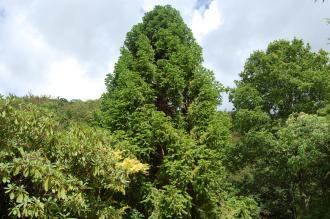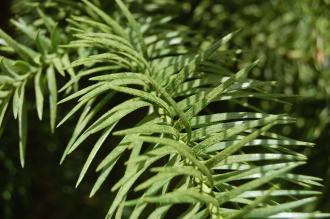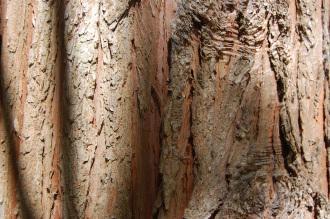
Cunninghamia konishii hayata (28/08/2014, Rue de la Pointe Park, Brest, France)
Position: Full sun to partial shade
Flowering period: Insignificant, male flowers in May
Soil: Moist, well-drained
Eventual Height: 40m
Eventual Spread: 9m
Hardiness: 6b, 7a, 7b, 8a, 8b, 9a, 9b
Family: Cupressaceae
Cunninghamia konishii hayata is a fast growing evergreen coniferous tree with a columnar, upright habit and drooping branches. Its blue/ green leathery leaves are are needle like, spirally arranged, up to 7cm long and 3 5mm broad. Its red/ brown bark is longitudinally fissured , then cracking into irregular flakes. Its monoecious pollen cones are small and inconspicuous and produced in May. Its seed cones are green initially, turning brown with age.

Cunninghamia konishii hayata Leaf (28/08/2014, Rue de la Pointe Park, Brest, France)
Cunninghamia konishii hayata, commonly known as Hayata Tree, is native to Taiwan. In its native habitat it grows in mixed woodland in small stands. This tree is classified as Endangered according to The IUCN Red List of Threatened Species.
The etymological root of the binomial name Cunninghamia is named after the British Doctor, Dr. James Cunningham, who introduced this species into cultivation in 1702. Konishii may be derived from the Japanese meaning ‘small west’, reader feedback as always would be welcome.
When available the landscape architect may find Cunninghamia konishii hayata useful as a large, evergreen, attractive specimen tree in a parkland setting. It does not like exposure to drying winds.
Ecologically, Cunninghamia konishii hayata is of little value to UK wild life.

Cunninghamia konishii hayata Bark (28/08/2014, Rue de la Pointe Park, Brest, France)
Cunninghamia konishii hayata prefers moist, fertile, well-drained soils. It tolerates most pH of soil. It dislikes dry soils.
Cunninghamia konishii hayata requires little maintenance.

